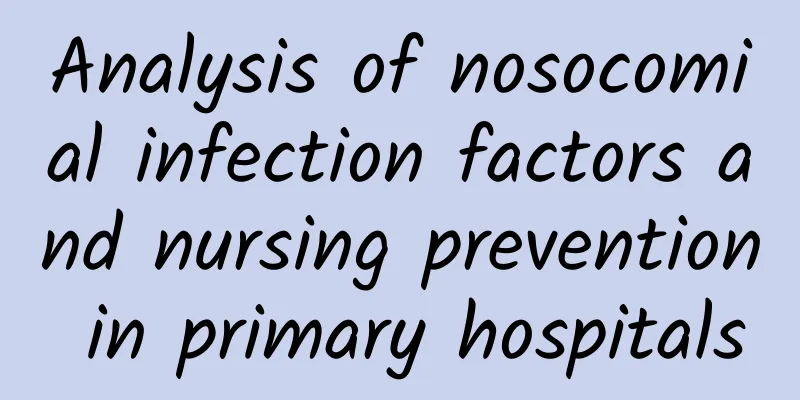Analysis of nosocomial infection factors and nursing prevention in primary hospitals

|
Hospital infection refers to infections acquired by hospitalized patients in hospitals (excluding infections that started before or existed at the time of admission), as well as infections acquired in hospitals after discharge, and also covers infections acquired by hospital staff in hospitals. This public health issue not only affects the treatment effect and recovery process of patients, but may also endanger the lives of patients and medical staff. In particular, in primary hospitals, the risk of hospital infection is more prominent due to limited resource allocation and uneven management levels. 1. Main factors of nosocomial infection in primary hospitals 1. Lack of management system and awareness Grassroots hospitals often have deficiencies in their management systems, an imperfect hospital infection management system, and inadequate responsibility implementation. Some medical staff and managers are not fully aware of the harmfulness of hospital infections and lack the necessary knowledge of aseptic techniques and disinfection and isolation. In daily diagnosis and treatment, basic infection prevention and control measures are ignored. For example, medical devices such as thermometers and stethoscopes are not disinfected after each use, increasing the risk of cross infection. 2. Antibiotic abuse In primary hospitals, due to the lack of knowledge on the application of antibiotics and the drive for economic benefits, the abuse of antibiotics is widespread. People believe that the use of high-end antibiotics can quickly cure diseases, but the result is the emergence of drug-resistant strains and dysbiosis, which increases the difficulty of treatment and the risk of infection. 3. Environmental and equipment issues Grassroots hospitals often face problems of backward facilities and unreasonable layout. For example, there is a lack of effective isolation between outpatient clinics and wards, patients with different diseases are placed in the same room, and there are no clear isolation signs and conditions in infectious disease wards. In addition, medical waste and domestic waste are mixed and there is a lack of effective sewage treatment and mosquito and fly control measures, which all provide conditions for the spread of germs. 4. Patient factors Some hospitalized patients, especially those with low immunity, such as infants and the elderly, and those who need long-term treatment or invasive procedures, are at high risk of hospital infection. These patients have weak immunity, and the complex and high levels of pathogens in hospitals make them very susceptible to infection. 2. Nursing preventive measures 1. Improve the management system and enhance the sense of responsibility Grassroots hospitals should set up special hospital infection management teams, formulate comprehensive infection control plans and systems, and clarify the responsibilities of personnel at all levels. Strengthen the training of medical staff to improve their awareness of hospital infection and their ability to prevent and control it. At the same time, the infection management system should be included in performance appraisal to ensure that all measures are effectively implemented. 2. Strictly implement the disinfection and isolation system Medical staff should strictly abide by the aseptic technology and disinfection and isolation system, regularly disinfect medical equipment and items, and ensure that they are disinfected after each use. During the diagnosis and treatment process, personal protective equipment such as masks and gloves should be worn to reduce the risk of cross-infection. For patients with infectious diseases, they should be managed and treated in strict accordance with isolation requirements. 3. Rational use of antibiotics Grassroots hospitals should strengthen supervision over the use of antibiotics, formulate scientific and reasonable use standards and processes, train doctors on the use of antibiotics, and improve their ability to use drugs rationally. At the same time, a complete antimicrobial drug monitoring system should be established to regularly analyze the use of antimicrobial drugs and promptly detect and correct abuse. 4. Improve environmental and equipment conditions Grassroots hospitals should increase investment in the environment and equipment to improve medical conditions. They should optimize the layout of wards to ensure effective isolation between outpatient clinics and wards. They should strengthen sewage treatment and medical waste management to prevent the spread of germs. Damaged or aging equipment should be replaced or repaired in a timely manner to ensure that it functions properly. 5. Strengthen patient care and monitoring Comprehensive care and monitoring should be provided to hospitalized patients, especially those with low immunity and high-risk patients. Patients' infection indicators should be tested regularly to promptly identify and treat potential sources of infection. Patients' health education should be strengthened to improve their self-protection awareness and ability. At the same time, family members of patients should be educated to guide them to assist the hospital in infection prevention and control. 6. Enhance occupational protection awareness among medical staff As an important force in hospital infection prevention and control, medical staff should improve their awareness of occupational protection. During diagnosis and treatment, they should strictly follow the standard operation and avoid direct contact with the patient's secretions or contaminants. They should undergo regular physical examinations and vaccinations to ensure their own health and safety. At the same time, hospitals should provide necessary protective supplies and equipment support to provide medical staff with a safe working environment. 3. Conclusion The management and control of nosocomial infection in primary hospitals is a complex and arduous task, which requires the joint efforts of hospital managers, medical staff and all sectors of society. By improving the management system, strictly implementing the disinfection and isolation system, rationally using antibiotics, improving environmental and equipment conditions, strengthening patient care and monitoring, and enhancing the occupational protection awareness of medical staff, we can effectively reduce the risk of nosocomial infection in primary hospitals and protect the lives of patients and medical staff. Let us work together to build a safe, healthy and harmonious medical environment. Author: Medinaim Aubli, Shule County People's Hospital, Kashgar, Xinjiang |
<<: [Health Lecture] How should the diet of the elderly be adjusted?
>>: Protecting our "light" - preventing myopia, you and I are together
Recommend
Dull pain in lower abdomen just after menstruation
Many women have menstrual cramps during their men...
What to do with rhinitis during pregnancy
Rhinitis is a very common ear, nose and throat di...
Yaowa Quiz | Will long-term use of sitagliptin and metformin tablets lead to vitamin B12 deficiency?
Sitagliptin metformin tablets contain metformin, ...
Does your body temperature rise immediately after ovulation?
Many people feel that their body temperature will...
How to store live abalone? Can abalone be frozen and stored?
Abalone is fresh, tender and delicious, and is a ...
Can I take a bath during confinement?
Basically everyone takes a bath every day. Even i...
What foods should not be eaten for ovarian cysts?
In life, we often hear the saying that being able...
What to do if the embryo has no germ
After becoming pregnant, women must pay attention...
What is vaginal discharge?
Due to sexual stimulation and mental excitement, ...
School is back, here is a guide for children who have never had a positive experience
As the Lantern Festival comes to an end, universi...
Taboos of postpartum confinement
Women need to stay in confinement after a normal ...
How effective is Garnier cleansing water in removing makeup? What is the texture of Garnier cleansing water?
Garnier cleansing water is also a product that co...
Do you have back pain from sitting for a long time in the office? Here are some tips for recovery
With the rapid development of the information age...
What does contraction feel like and where does it hurt?
What are contractions and where does it hurt? Ute...
What are the benefits of washing your hair with beer? Can washing your hair with beer remove oil?
Not only can beer be drunk, but it can also be us...









